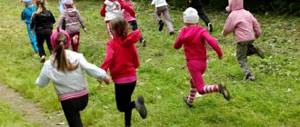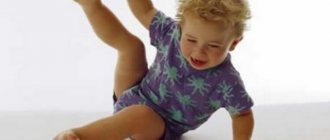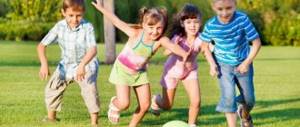Outdoor games have long been a well-known pastime for children. All folk traditional games can be divided into two groups: 1) winter games - games indoors, in a hut, 2) spring and summer games - games in the fresh air. All these games belong to the group of games with rules. And they are very important for the child’s health and for his preparation for school. After all, it is in playing with rules that a child learns to manage his behavior, to be guided by the rules in his activities, and this is the development of arbitrariness of behavior - the most important condition for success in school.
Many of these ancient outdoor games are now forgotten. I want to tell you a little about them. In this article you will find both outdoor games that can be played together and games for a large group of children - for a children's group or a parent-child group.
Outdoor games: ball games.
I know.
This outdoor game develops children's memory and attention. You can even play it together - a mother and one child.
Game option No. 1.
We hit the ball, bouncing it off the ground or off the asphalt. For each blow we pronounce a new name, repeating the previous one. For example:
I know one girl Alena.
I know two girls - Alena and Olya.
I know three girls - Alena, Olya and Vera.
I know four girls - Alena, Olya, Vera, Sveta...
The main thing is not to lose count and repeat the entire sequence correctly, without confusing the names in their order.
If a player goes down, he passes the ball to the next player. If you can never get lost, then he is a winner!
Similarly, you can call trees, cities, flowers, vegetables, fruits, minerals and any other names.
Game option No. 2.
This version of the game is much more difficult, as it requires switching attention. And you also need to not lose count and repeat the names in the chosen sequence.
Two parallel rows of names are lined up. For example.
I know one girl Alena. I know one boy, Petya.
I know two girls - Alena and Olya. I know two boys - Petya and Vova.
I know three girls - Alena, Olya and Vera. I know three boys -
Petya, Vova and Yura.
I know four girls - Alena, Olya, Vera and Masha. I know four boys - Petya, Vova, Yura and Seryozha and so on.
Such games are very useful for developing a child’s memory and attention, preparing him for school, and developing the ability to quickly switch and concentrate.
Big ball.
To play you will need a large ball that you can kick. All players face in a circle and join hands. The driver stands in the center of the circle and tries to roll the ball out of the circle with his feet. The players don't let him do it. If one of the players misses the ball, he becomes the driver. But the second round of the game goes differently. The players now stand facing out of the circle and join hands. The driver's task is to roll the ball back into the circle. If this is successful, then the player who missed the ball becomes the driver.
Again, the children stand facing in a circle and the game is repeated.
The rule of the game is that the ball cannot be picked up, you can only roll it with your feet.
This game can even be played by three people. Then a couple of players stand facing the driver and form a hoop. Their task is not to let the ball into the goal, that is, among themselves.
Ball up
- Everyone stands in a circle. The driver throws the ball up with the words: “Ball up!” (in some versions of this game, fictitious words are pronounced that do not exist in the Russian language; such a word - a signal - can be invented together with the children and shouted out in this game). At this time, all players run away from the driver as far as possible.
- The driver catches his ball and shouts at this time: “Stop.” All players who have run away must stop and freeze in place.
- The driver’s task is to throw the ball and hit or stain one of the players with it. If he managed to stain a player, then this player becomes the driver in the next game. If it was not possible to stain the player, then the same driver will have to drive again.
Rules of the game:
- The driver throws the ball up as high as possible.
- The driver catches the ball either from the air or from one bounce from the ground.
- If the player does not stop at the “Stop” signal, then he needs to take three large steps towards the driver.
- Players should not hide behind objects or trees.
Child development center – kindergarten “Smile”
Summer is the favorite time of all children, because in warm weather you can spend almost the whole day outside.
One of the most important issues in the work of a preschool institution in the summer is the organization of children's leisure time. On the one hand, good weather and the opportunity to spend enough time outdoors largely alleviate the severity of this problem. However, children quickly get bored with their usual games, and if their activity is not used, they strive to fill their time with a variety of forms of activity and, in the absence of guidance, are capable of causing harm to both themselves and others.
It is important for a teacher to find a balance between children’s independent activity and pedagogically organized leisure, so that events and holidays do not become an end in themselves, but are organically woven into the life of a preschool institution.
The optimal form of organizing children's leisure in the summer may be an event that does not require significant preparation on the part of children, has developmental and educational functions, and is carried out in an emotionally attractive form. In addition, it is important that this activity does not also require cumbersome preparation on the part of teachers. This type of activity is a game.
Game clock
During the play hour, children get acquainted with various games (folk and modern). As practice shows, modern children often do not know folk games. Older preschoolers are interested in lotto, checkers, chess, etc. Learning these games with children and further consolidating them in everyday play activities significantly enriches children's leisure time.
Travel games.
The travel game is a sequential visit to various points on a previously prepared route. The children are given a task that has a playful nature (they go to Tsar Berendey, to the sweet tree:). It is necessary to organize stops along the route where children will be offered various games and tasks. Teachers share functions among themselves: some of them accompany the children along the route, while others are at their points and organize tasks for them.
Children's sports competitions belong to the category of outdoor competitions. They vary significantly depending on the age of the child. After all, for such fun, dexterity is very important, which, in fact, develops in the process of such competitions. Dexterity is determined by the ability to master new motor reactions and quickly adjust one’s movements if necessary, depending on the changing situation.
Agility, so necessary in sports competitions, develops rather slowly. There is no point in talking about sports competitions for young children; for their athletic development at first, it is enough to use simple games, children's swings and bicycles.
Children's sports competitions develop dexterity, the ability to coordinate movements, and action in a limited time and space (children's playground). Team competitions develop a healthy spirit of competition, and hanging swings have a beneficial effect on coordination of movements and the vestibular system.
Ball games. Despite its simplicity, ball games are very useful for children, as they develop almost all types of muscles. And it doesn’t matter whether the baby throws or catches the ball, he trains coordination of movements and vision. You can come up with a wide variety of games for summer boys with a ball that you can either throw or kick.
Ball activities occupy a special place among children's sports games. For example, such an exciting competition as “Children’s volleyball”. The site is marked. A rope is stretched in the middle at a height of two meters. Children divided into two teams (the number is not important, as long as it is equal) stand on opposite sides of the rope. The first two competitors go to the start line, marked two meters from the rope. They pick up a ball and at the same time throw their ball over the rope. The task of the rest of the team is to catch the ball in order to prevent it from falling to the floor. Then the second competitors serve, and so on. The winnings go to the team on whose court the opponents' ball fell less often. During the competition, agility, accuracy, and reaction speed develop.
Another ball game no less beloved by children is “Dodgeball” . Here, the participants of one of the teams stand on opposite lines of the outlined area. And the members of the other team move on the field between these lines, dodging the ball thrown by their opponents with the intention of hitting the competing team on the field. When the ball hits the target, the child who was hit leaves the court. But if a participant in the court catches the ball, then he has the right to return the eliminated loser or count this point for the future. After all team members in the field have been eliminated, the teams switch places. This sports battle also trains speed, agility, accuracy and coordination of movements.
"Bowling". All children love the game, which is a children's version of bowling. For this competition you need pins and a ball. Ten pins lined up in a row are struck from a distance of ten meters. Each participant has the right to five attempts. For each pin knocked down, the participant gets a point. The one who knocks down the most number wins. Here, accuracy and coordination of movements are developed, as well as the ability to impart the necessary acceleration to the ball.
And it’s impossible to ignore such a children’s sports competition as “Pioneerball” . For the Pioneerball competition, a volleyball court is used. Team fun. Each team consists of 7-9 guys, located on both sides of the net in three rows. Those participants standing in the second row each have a ball. When the referee whistles, the game begins and the ball is sent through the net to the other team's court. Balls flying over the net are caught or picked up and, as quickly as possible, sent through the net to the opposite side. If at any time there are two balls on the same side of the court, the competition stops and the team without any balls on the side receives a point. A point can also be earned if the opponent dribbles the ball under the net or sends the ball out of bounds.
The duration of a sports battle can be either up to 15 points, or five minutes for each of the two periods. The third period is carried out in case of equal scores in the first two. If the ball touches or hits the net when serving, the serve is repeated and no points are awarded to anyone. When a point is won, the rows of participants on the court change. In this game, in addition to dexterity and speed of reaction, team spirit and coherence of interactions between competing teams are fostered.
Also popular in the summer are folk outdoor games with different objects (with a ball - “Candles” (Russian folk game), “Lord of the Hole” (Kabardian folk game), “In the Knot” (Tatar folk game), etc.); games with jumping, maintaining balance, accuracy and power games ("Guess" (a game of the peoples of Dagestan), "Cockfight" (Mari folk game), "Lame Fox" (Tatar folk game), games with running ("Snake" ( Russian folk game), “Sticky Stumps” (Bashkir folk game), “Vestovy” (Yakut folk game), “Pegs” (Mari folk game), etc.).
In nature, one of the simplest, most accessible and entertaining games for children 6-7 years old is badminton. A very exciting game with a plastic plate (Frisbee). Any number of people can play it. For example, ten players stand in a circle at a distance of 4 steps from each other. Children throw the plate to each other in any direction, but not to those standing next to each other.
Using a plastic plate, you can also play the game Sniper : at a distance of 8 meters from the starting line, various objects are placed on the ground - a cube, a pin, a box, etc. Children try to knock them down with a plate. Each player in turn approaches the starting line and throws the plate 3 times, trying to hit the target. The most accurate participant in the game wins, knocking out three objects in three attempts.
You can also play games that develop the child’s mental activity and train concentration. For example, the game “On the contrary” . Children stand in a circle. The driver throws the ball to someone and says: “It’s light”; the person who catches it must say the word in reverse, i.e. opposite in meaning. The player answers: “It’s dark” and returns the ball to the leader, who continues the game (wide-narrow, hot-cold, etc.). You can pronounce different parts of speech: nouns, verbs, and adjectives. A player who does not answer or hesitates for more than 10 seconds leaves the game.
. ” The children form a circle, and the driver counts them in numerical order. The driver stands in the center of the circle. The presenter loudly calls out two numbers. The numbers called must be swapped. The driver’s task is to get ahead of one of them and take his place. The one left without a seat goes to the driver’s place. The numbers that were assigned to players at the beginning of the game should not change, even when one or another of them becomes a temporary driver.
Drawing with crayons.
It is much more interesting to draw with children outside. Take a set of colored crayons with you and feel free to paint the asphalt. Moreover, you can draw not only people and pictures, but also learn letters, numbers, etc. With older children you can play hopscotch and other similar games.
Games with hoop and jump rope.
You can also improve your child’s physical fitness with the help of a hoop and a jump rope. Since children cannot use these equipment for their intended purpose, you can first offer, for example, a small hoop as a steering wheel, or place the hoops edgewise so that the child crawls through the tunnel.
Blowing soap bubbles.
Such a game will not only be useful, but also bring a lot of fun! The main thing is to be patient and teach your child to blow soap bubbles. Summer games for children with the help of soap bubbles will not only be rainbow-colored, but also fun entertainment in the form of chasing bubbles. By blowing bubbles, kids exercise their lungs. Besides, blowing in one direction is not such an easy task! You can blow soap bubbles not only through a stick, but also through a straw, and the larger the hole, the larger the bubbles you will get.
The most popular summer games in kindergarten are related to water and in the water.
But even with a minimum amount of water, you can organize a water carrier relay race. For this game you will need two stools, on one of which a container of water is placed, and on the other an empty similar vessel. The children's task is to transfer water from one vessel to another using other objects. Water can be carried in molds, ladles, and plates. The team that splashes the least amount of water wins. You can complicate the game, which develops accuracy and coordination of movements, by establishing a specific method of carrying water: in one hand, on a flat saucer.
Divers
The presenter lowers several clearly visible objects under water to the bottom. Players take turns diving, retrieving objects from the bottom. The child who gets the most items at one time wins.
Dwarfs - Giants
Children stand waist-deep in water. The presenter gives the signal by shouting the word: “Dwarfs!” Everyone sits in the water. Behind the signal: “Giants!” – all players jump up. The one who makes a mistake is out of the game. The one who remains wins.
Tag
The players stand in a circle at arm's length from the driver, who is located in the center. The driver, at a signal from an adult, begins to salt those who did not have time to dive into the water. Those who have surfaced cannot be salted.
Get into the circle
The presenter throws an inflatable ring into the water. Children are standing on the shore. They have small balls in their hands. Players take turns throwing them into the center of the circle, while continuing to stand on the shore. Each player has 2 – 3 attempts. The one who hits the target the most wins.
Playing with pebbles
Children love to collect stones. Collect stones of different colors and sizes in a bucket, pour them into a bowl of water and wash. When you have washed the pebbles, you can start playing with them. You can put stones in a bucket and transfer them to some place, you can do this with a spatula or cup. You can surround a flower bed or tree with pebbles. You can draw a shape on the ground with a stick and lay it out with stones along the contour.
An outdoor game with a didactic orientation.
Outdoor play with a didactic orientation, in contrast to strictly regulated movements, is always associated with the initiative moment of solving motor and didactic problems and takes place against an emotional background that stimulates motor activity and mental performance, delaying the occurrence of fatigue. In an outdoor game with a didactic orientation, two principles are harmoniously combined: educational-cognitive and play-motor.
In an active game with a didactic orientation, children learn to combine movement and scattered knowledge and facts acquired in classes and in everyday life, systematizing them into a single holistic idea of the surrounding reality.
In fact, there are a lot of options for summer games with children, just use your imagination, and every day of summer will be a holiday for you and your children.
Such a vacation in the summer will strengthen your immune system and allow you to gain strength.
Outdoor games: play on the swing.
Game "Popinuh" with a patchwork ball.
Previously, on Easter days they made large swings that could accommodate many people, and not only children, but also adults swung on such swings.
Now in our yards the swings are designed for only one child. What to do if there are many people who want to swing on a swing and an eternal dispute arises: who is first? The traditional “give way to the little one” or “give way to the girl” is usually perceived with resentment: “Why should I give in again, because I also really want to swing, even though I’m a boy and only a year older.” Of course, you can choose the order according to a counting rhyme or lot, so that no one is offended.
But there is another way - very fun and interesting. This is a traditional Russian swing game “Popinukha” - a fun game so that no one stays too long on the swing and everyone can ride on it. In the past, both children and teenagers played this game. The game develops coordination of movements and dexterity, ingenuity, and the ability to observe. After all, to win, you need to predict the trajectory of the ball and throw it correctly to the leader. Here's how to play this game outdoors.
What do you need to play on a swing?
Previously, girls used to sew a special ball for this game - “popinhuha” with a diameter of up to 20 cm. The ball was stuffed with rags, tow, sawdust and decorated with ribbons and braid. Instead of a ball, they used a bunch of straw, a mitten, an old bast shoe or another object that was at hand.
Nowadays, the easiest way to make a kick ball is from an unnecessary sock or colored children's tights.
1.Cut off the “pipe”. Tighten the hole on one side with a strong thread.
2.Fill the resulting “bag” with padding polyester or rags (old unnecessary things, cut into small shreds). Women's nylon tights that have gone out of use are also suitable as padding - the ball will be elastic.
3.Next, tighten the second edge of our “pipe-bag” with thread. And decorate the tightening area with colored buttons or ribbon bows.
You can sew it differently: make a bag out of bright colored cotton fabric, fill it with rags and tie it. It will also turn out to be a kick. You can use an out-of-use mitten, stuffing it with rags and decorating it with buttons and bows. Look at what other items you have, they will all be suitable for becoming a booty in this game.
A sounding object was always placed in the middle of the popinukh ball. These days it could be a rustling flower package or a bell. You can fill a plastic Kinder Surprise box with peas. Or put small peas in walnut shells. In folk tradition, a birch bark tube with peas inside was placed inside the popinukha.
How to play "popinhuha"
Game option No. 1.
- One child is swinging on a swing (we choose him based on the counting rhyme). Other children stand facing the swing. The person swinging on the swing sings 1-2 verses of the song (this is agreed upon in advance).
- The players take turns throwing a kick ball to the person sitting on the swing (they throw the kick ball at the feet of the child swinging on the swing so that he can hit the ball, that is, kick it). To make the kick stronger, it is better to throw the ball when the swing is moving towards the thrower.
- After the kick, all players rush to catch the kick ball. The goal is to catch the ball before it hits the ground.
- If the player managed to catch the ball, then he sits on the swing instead of the previous child and swings on it. He begins to sing his 1-2 verses, then they throw a slap at him, he pushes it away from him, and so on as the game progresses.
- If the person swinging on the swing could not hit the ball from his knees or feet, he leaves the swing. Then the child who threw the ball sits on the swing.
- If the person swinging on the swing hits the ball, but the players do not catch it, then he remains swinging on the swing.
Game option No. 2.
- One child sits on the swing (we will choose him according to the counting rhyme). All other children who also want to ride on the swing stand near the swing facing the swinging child.
- A child swinging on a swing sings a song (they agree in advance how many verses he will sing). You can recite poetry, sing ditties, or count to 20 - any task will do. You will find several swing ditties for this game below.
- After listening to the end of the ditties (song, poem, counting, etc.), the players take turns throwing the pop-ball to the person sitting on the swing. If a child swinging on a swing was able to catch the ball, then he remains swinging. If not, then he gives way to the player who threw the kick.
Poems for swing games
Swing choruses - “profits” for playing on a swing
Swing ditties
Games with balloons
There are many summer games with inflatable balloons. Quite interesting and emotional games can be played with balloons filled with water.
I hope my tips will help organize a massive vacation for your children in the summer . A few more photos of ideas for playing with children outdoors.
Rubber band games, edible, inedible and others
By subscribing to our updates, you will receive a lot of useful information. In the meantime - see you again!
Outdoor games: outdoor games with a group of children.
Zarya-zaryanica.
This is a round dance game. All children stand in a circle. And Zarya the Zaryanitsa stands behind the circle and holds a handkerchief in her hands. The round dance goes in one direction in a circle, and Zarya Zaryanitsa goes in the other direction around the round dance.
Children sing or say:
“Zarya-Zaryanitsa - to these words the round dance and Zaryanitsa move in a circle in different directions. The red maiden walked across the field, dropped the keys, golden keys, blue ribbons, entwined rings.”
Next, Zarya puts her handkerchief on the shoulder of the player in the round dance and says: “I went for water!” All players say in unison:
“One, two, three, Don’t be a crow!” And run like fire!”
At these words, Zaryanitsa and the child, who had a scarf placed on his shoulder, run in different directions around the round dance and run around a full circle. Whoever runs around the round dance faster and stands in it, taking a place, will play in the round dance. The one who did not have time becomes Zaryanitsa and the game continues.
Burners.
How to play burners:
Children stand in pairs, one after another, in a column. In front of this column, the driver stands facing the children - the “burner”.
The children chant the words:
“Burn, burn clearly, so that it doesn’t go out! Stand at your hem, Look at the field. There are trumpeters riding and eating rolls. Look at the sky: The stars are burning, The cranes are shouting: “Gu-gu, I’ll run away, One, two, Don’t be a crow, But run like fire!”
In response to these last words, the children from the last pair in the column unclasp their hands and run forward along the column to its beginning. Each player runs from his side. And the burner is trying to stain them.
If the players managed to run and stand as the first pair in the column, then the burner turns on again and “burns.” If the burner stains a player, then that player becomes a burner in the next game and the game is repeated.
Corners.
Children have been playing this game outdoors for many decades and centuries in different regions of Russia - Vyatka, Tobolsk, Astrakhan, Vladimir. It is also known that children played this game in Europe. For example, in France it existed under the name “Four Corners”, and the driver in France, instead of a mouse, was called “gap” or “pot”.
They used to play this game in the log house. Then - in my childhood - we also played this game, and we came up with it ourselves, but instead of a log house we used a square sandbox with sides in our yard. Instead of a log house or sandbox, you can simply draw a square with a side of about 2.5 meters on the ground or asphalt.
How to play corners?
You can play with 5 people or more. Four people stand in the corners, and the fifth player is the mouse. The mouse stands in the center of the square.
The mouse says: “From corner to corner!”
At these words, the children change places. You need to run across and take a place in another corner. The mouse also tries to occupy the vacant corner. Whoever is left without a corner becomes a mouse, stands in the middle of the sandbox or square and leads in a new game.
In another version of the game, it is not the mouse who speaks the words, but the players who speak to the mouse:
“Mouse, mouse, Sell the corner. For the awl, for the soap, for the white towel, for the mirror!”
and change places.
Confusion.
This wonderful and very interesting ancient folk game in the fresh air is often used in modern psychological training for children and adults. It is very useful for bringing people together, removing barriers, and bringing a joyful mood. This game can be played indoors, in a gazebo, on the veranda, at a birthday party, with guests, in the park or in the forest, in the country or in the yard. Moreover, everyone plays this game together - adults and children.
How to play confusion.
Mother and daughter are selected from the players. Mom leaves. All players join hands with each other in a circle. My daughter is confusing this round dance - you can crawl under your arm like a gate, step over your arms, turn around. The main condition is to do this without releasing your hands. When the players are completely confused with each other, they call their mother: “Mom, unravel the thread!” Just don’t tear it!”
Mom tries to unravel the confusion and return everyone in the circle to their place. The rule is the same - players should not release their hands when untangling.
If the mother has untangled the confusion, then a new mother and daughter are chosen. If not, then mom is playing another game.
If there are few participants in the game, then you can get entangled with a rope.
Games for small children outdoors in summer
Remember that young children (2-4 years old) still have poor coordination of movements; when playing group active games, they can get injured. Therefore, pay attention to establishing tactile contact between children. In kindergarten they often play educational games. Here are examples of entertainment:
Round dances
The little ones willingly dance in circles and play snake. But such fun requires an area with a flat surface so that the little ones don’t stumble or hurt themselves. Line up the little participants and ask them to hold hands. Stand at the beginning of the “snake” and lead the “tail” behind you, changing the direction of movement. And if you also turn on the music, it will be doubly fun!
"Tell someone else"
The game is fun and develops a competitive spirit. Children 4-5 years old are divided into groups of 4 people, stand one after another. The item being passed on could be a cardboard thermometer under your arm, or a stuffed animal held between your knees, a ball, or even water (for teenagers)! A stick, a ball or a thermometer, and to make it more difficult, you can carry an egg on a spoon in your mouth, which you need to give to a friend. You can also make it more difficult by passing the object without using your hands. The fastest and most agile win!
If there are a lot of kids, then you can hold entire tournaments using this game. For example, first 4 teams participate, and the rest are sick. Then the participants and fans change places.
“The sea is agitated - once!”
For children in the middle group, it is possible, and even necessary, to organize outdoor games. You can start with your favorite game “The Sea Is Troubled,” which develops coordination of movements in the players and attentiveness in the driver.
The rules are very simple: one player turns away and says the well-known counting rhyme, and at this time the participants can run and frolic. After the phrase “Sea figure, freeze!” everyone must be frozen in place in intricate poses. The driver goes around the figures and looks to see who moves. A child who cannot stand still becomes a “vada.” By the way, you can make the game even more fun by promising the children a prize for the most beautiful figure.
"Musical Chair"
Place the chairs in a circle with the seats facing outward, their number is 1 less than the number of children.
Fun music is playing and the children are moving freely. When the music stops, you need to sit down. The participant left without a chair is eliminated.
Musical games develop attentiveness and reaction speed. Instead of chairs, you can use pebbles, pillows or something else. Instead of music, you can recite a rhyme, clap, or sing.
"Complicated traffic light"
The game is suitable for older children. It will help not only improve knowledge of colors, but also practice counting skills. Basic positions - “vada” turns his back to the participants, the distance between them is at least 5 meters. The presenter names the color and sets the price, for example:
- 2 midgets (2 small steps, heel to toe);
- 3 giants (3 large steps, as far as the child’s );
- 1 saucepan (1 step with a turn around);
- 5 ducklings (here we mean squatting steps).
Children who have the named color in their clothes go through the indicated route. The one who reaches the driver first will win. As you can see, this game is not only educational, but also sports . By the way, the kids like to come up with their own elements for the “traffic light”.
Obstacle course
For preschool children, you can organize an obstacle course. This obstacle course can be anything - from tires, ropes, stumps, tapes, rubber bands and other things. On that day that I was talking about, it was just such a game that saved us - we pulled a rope between the trees. For teenagers and adults, the task was to climb without touching the rope, but for kids they could hold on to it and touch it.
Such sports games develop in them the desire to be first, strengthen the child’s muscles, and make him dexterous. And watching such competitions from the outside is a pleasure! It’s better to set up an obstacle course outside with fun music.







